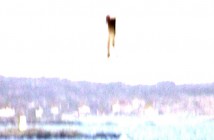Cast: Jean Dujardin, Berenice Bejo, John Goodman
Director: Michael Hazanavicius
Country: France | Belgium
Genre: Comedy | Romance | Drama
Official Trailer: Here
For an alternate take on The Artist, check out Kevin Ketchum’s review.
The Artist is one of those movies that could easily become a holiday mainstay, with families gathering around to soak up its magical whimsy year after year, allowing it to put them in the spirit of the season. It’s not a holiday movie, mind you, but then neither was The Wizard of Oz – these are the kinds of films that speak to a pure, old-fashioned, soul-stirring, toe-tapping enchantment. In very simple, clear strokes, this is a film that will bring people together – a universal story of empathy and restoration, about the bittersweet journey to find one’s voice.
Funny, that…considering this is a silent film. Written and directed by Michel Hazanavicius, The Artist is one of many 2011 films that seek modern-day catharsis by reaching back to the past. Here we have a film communicated in the language of the Silent Era, about the decline of a Silent Era superstar, which speaks to the crushing transience of celebrity and the fleeting fair-weather attention of the Hollywood star system. As Scorsese’s Hugo showed us the birth of cinema itself and Spielberg’s War Horse immersed us in the Golden Age of the American cinematic frontier, so does The Artist transport us to a classical world sumptuous black-and-white photography and broad emotional presentation. When viewed through the modern eye, the silent film signposts become clever modern reference points and the simple human themes speak to our nostalgic memories and blunt our contemporary cynicism. As a result, The Artist – theoretically the year’s most old-fashioned film – becomes a gem of post-modern significance, celebrating a bygone era by commenting on it, fleshing it out with broad universality.
The film sparkles with the joy of performance, led by the extraordinary charms of Jean Dujardin and Berenice Bejo, two remarkable, multi-talented French actors who, with their infectious charm and deep expressiveness, seem to have been transported directly from the Silent Era. Dujardin is George Valentin, the biggest superstar in late-‘20s Hollywoodland, a slick entertainer who combines the goofy humor of Charlie Chaplin with the swashbuckling suave of Errol Flynn. Bejo is Peppy Miller, a bright-eyed wannabe, so star-struck when she meets Valentin that she plants an innocent kiss on his cheek. Photos of the kiss become front-page news, with headlines that read, “Who’s That Girl?”
“That Girl” becomes a rising star on the back of her well-publicized kiss – a rise that coincides with Valentin’s precipitous fall. The Artist takes place at the crossroads of the sound revolution, when the Silent Era faded away and Talkies became the standard. It is no accident that the film’s silent form becomes an extension of its protagonist, as Valentin bristles against the advent of cinema sound and quickly fades from the spotlight. Audiences no longer seem interested in the charms of silent performers; they want the newer, younger stars whose voices they can hear. We track Valentin’s fall from a ubiquitous celebrity to a faded star bankrolling his own projects to a depressed out-of-work actor auctioning his belongings to earn extra cash. Through it all, he remains psychically connected to Peppy, who supplants him as the star of the moment but whose reverence for his talent nevertheless grows stronger.
There is an infectious playfulness at work in The Artist, as Hazanavicius embraces the silent format to enliven his story with referential charms, evoking the sort of broadly emotional strokes that can only be captured in the simplicity of silence. Such simplicity can grow thin, as some other critics have indicted, and indeed, there is a stretch in the film’s melancholy midsection that is suppressed by its monotonous pantomiming of inward depression. The film is at its peak when it soars with delight, indulging the demonstrative glee of the form and immersing us in a lyrical black-and-white glow. There are sequences that blend breathtaking beauty with staggering creativity – a nightmare sequence in which a voiceless Valentin is driven mad by the incessant din of the sonic world that threatens him is remarkable in its innovative symbolism.
Dujardin and Bejo will be revelations for American audiences, carrying off the deceptively complex task of silent film acting. They are multi-faceted talents, endlessly charismatic, capable of communicating nuanced emotions with a simple, soulful glance. Similarly, Hazanavicius is an immensely talented director, reverent but innovative, telling a story about breaking free within the purposeful confines of the silent format. His film is a love letter to cinema, presented both in style and in content as a breakthrough. As Valentin and Peppy close the film with a show-stopping dance number, and we ever so briefly hear the heavy breath of their effort, it represents sound breaking through from silence, cinema breaking through the screen, and the resurgent confidence of a performer bursting through years of depressed turmoil.
[notification type=”star”]85/100 ~ GREAT. The Artist is a glowing love letter to the expressive simplicity of the Silent Era, one that will endure with audiences for years to come.[/notification]




